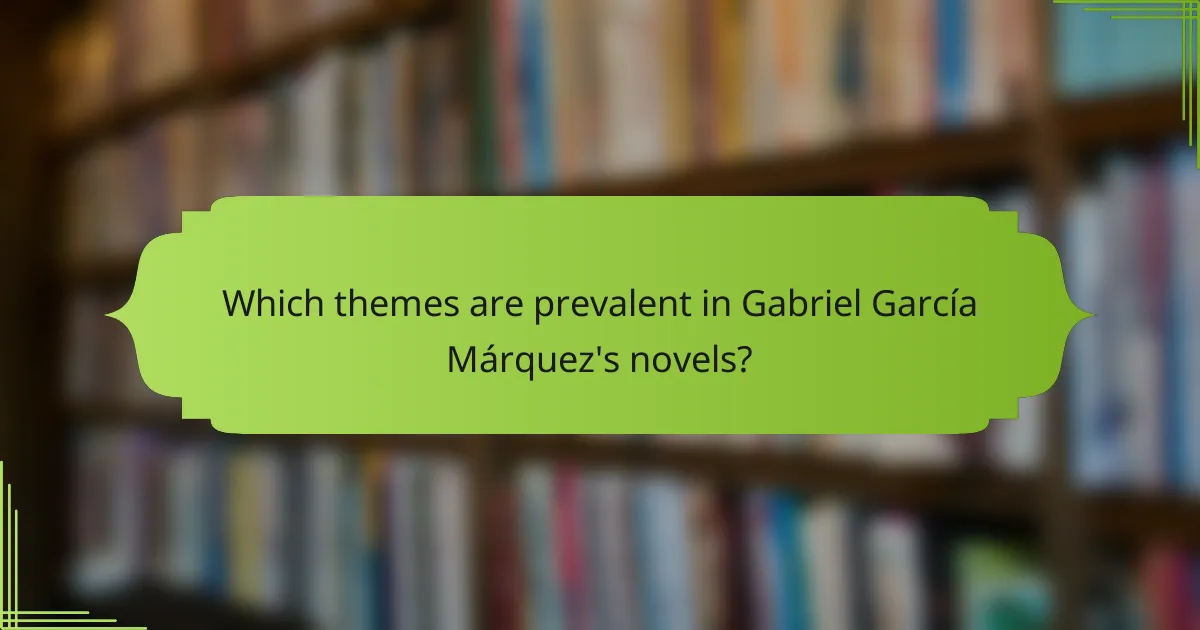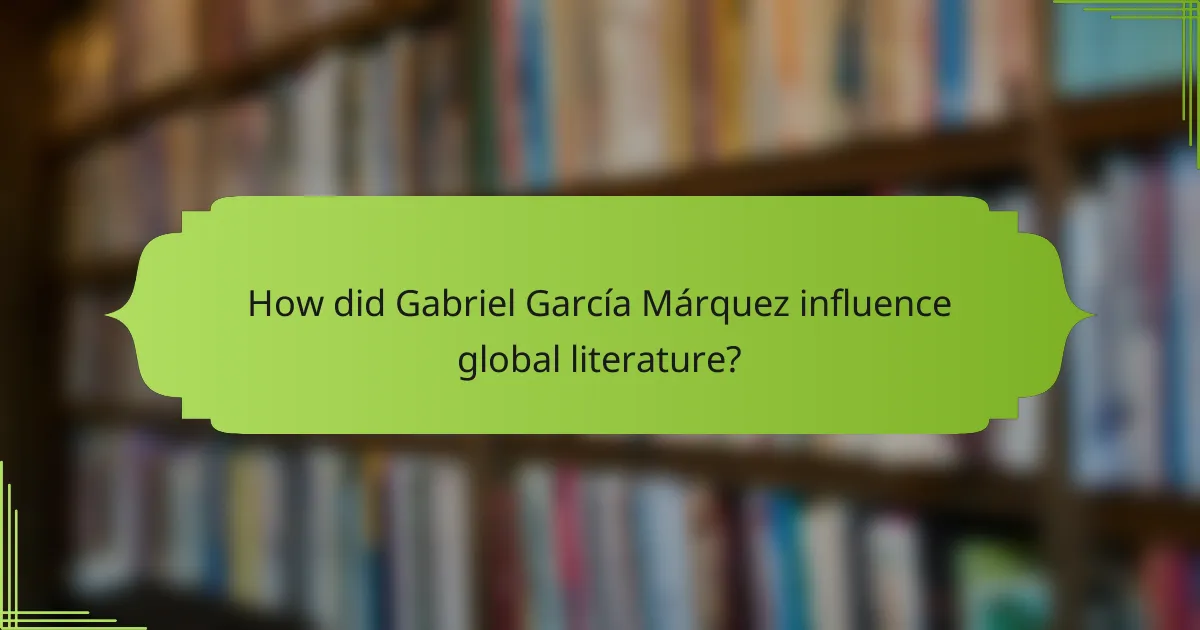Gabriel García Márquez profoundly shaped the genre of magical realism, blending the extraordinary with the mundane. His notable novels, including “One Hundred Years of Solitude” and “Love in the Time of Cholera,” explore themes of solitude, love, and the cyclical nature of time. His works reflect rich cultural significance and political history, influencing writers and readers globally. Understanding Márquez’s narrative style and thematic depth reveals the complexity of human experiences within Latin American contexts.

What defines Gabriel García Márquez’s contribution to magical realism?
Gabriel García Márquez significantly shaped magical realism through his unique narrative style and rich cultural themes. His works blend fantastical elements with everyday life, creating a distinctive literary experience. Notable novels like “One Hundred Years of Solitude” and “Love in the Time of Cholera” exemplify his ability to capture the essence of Latin American culture while exploring universal human emotions. His contributions have influenced countless writers, establishing magical realism as a vital genre in world literature.
How does magical realism manifest in his notable works?
Gabriel García Márquez’s magical realism manifests through the blending of fantastical elements with everyday life. His notable works, such as “One Hundred Years of Solitude,” illustrate this by incorporating supernatural occurrences in a realistic setting. The characters often experience extraordinary events that reflect cultural and historical contexts, revealing deeper truths about human nature. The narrative style emphasizes lyrical prose and rich imagery, making the surreal feel familiar and relatable. This approach not only captivates readers but also highlights the cultural significance of Latin American identity and history.
Why is magical realism significant in Latin American literature?
Magical realism is significant in Latin American literature because it blends reality with fantasy, reflecting cultural complexities. This genre allows authors like Gabriel García Márquez to explore themes of identity, history, and social issues. Notable works, such as “One Hundred Years of Solitude,” exemplify how magical realism captures the essence of Latin American life. The style emphasizes the extraordinary within the ordinary, creating a unique narrative that resonates globally.

Which themes are prevalent in Gabriel García Márquez’s novels?
Gabriel García Márquez’s novels often explore themes of magical realism, solitude, and the cyclical nature of time. His works reflect cultural identity, political history, and the interplay of love and death. The blending of the extraordinary with the ordinary creates a unique narrative style that captivates readers. Notable novels like “One Hundred Years of Solitude” and “Love in the Time of Cholera” exemplify these themes, highlighting the complexity of human experiences within Latin American contexts.
How do love and solitude shape his narratives?
Love and solitude profoundly influence Gabriel García Márquez’s narratives, shaping themes of connection and isolation. His characters often navigate complex relationships, reflecting the duality of love’s warmth and solitude’s chill. This interplay reveals the human condition’s intricacies, emphasizing emotional depth. In works like “One Hundred Years of Solitude,” love drives the plot while solitude underscores characters’ struggles, creating a rich tapestry of magical realism. This unique blend of attributes enhances the cultural significance of his storytelling, making it resonate across generations.
What role does political commentary play in his storytelling?
Political commentary enhances Gabriel García Márquez’s storytelling by infusing his narratives with social critique and historical context. His use of magical realism allows readers to explore complex political landscapes through allegory and metaphor. This technique engages audiences emotionally while reflecting the realities of Latin American culture. Notable works like “One Hundred Years of Solitude” exemplify how political themes intertwine with personal and communal histories, creating a rich tapestry of meaning. By addressing issues such as colonialism and dictatorship, Márquez invites readers to reflect on their own societal conditions.

What are the most notable novels by Gabriel García Márquez?
Gabriel García Márquez is renowned for several notable novels, including “One Hundred Years of Solitude,” “Love in the Time of Cholera,” and “Chronicle of a Death Foretold.” These works exemplify his mastery of magical realism and profound cultural commentary.
“One Hundred Years of Solitude” explores themes of solitude, history, and the cyclical nature of time through the Buendía family saga. “Love in the Time of Cholera” examines love’s endurance across decades, highlighting the complexity of human relationships. “Chronicle of a Death Foretold” presents a unique narrative structure that blends journalism and fiction, focusing on fate and societal norms.
Márquez’s novels often reflect his unique attributes, such as rich symbolism and intricate character development, making him a pivotal figure in Latin American literature. His storytelling continues to resonate globally, influencing countless writers and readers.
How does “One Hundred Years of Solitude” encapsulate his literary style?
“One Hundred Years of Solitude” exemplifies Gabriel García Márquez’s literary style through its intricate narrative and rich magical realism. The novel intertwines the ordinary with the extraordinary, showcasing the cultural significance of Latin America. Its unique attributes include non-linear timelines and vivid characterizations, which immerse readers in the fictional town of Macondo. This approach not only captivates but also reflects the complexities of human experience and history. The blending of myth and reality serves as a hallmark of Márquez’s work, emphasizing themes of solitude and cyclical time.
What unique attributes does “Love in the Time of Cholera” present?
“Love in the Time of Cholera” uniquely presents themes of enduring love and the intersection of time and desire. The novel’s portrayal of love as a lifelong journey distinguishes it within Gabriel García Márquez’s body of work. Its setting in a Caribbean town offers rich cultural context, enhancing the narrative’s depth. The use of magical realism allows for a blend of the fantastical with the mundane, creating a distinctive reading experience. The exploration of aging and the passage of time adds a rare dimension to the love story, revealing how love evolves throughout life.
Which elements make “Chronicle of a Death Foretold” a distinctive work?
“Chronicle of a Death Foretold” is distinctive due to its unique narrative structure and themes of fate and honor. The non-linear timeline creates suspense and engages readers by revealing the outcome at the beginning. This approach reflects the cultural significance of honor killings in Latin American society. The blending of magical realism with journalistic detail enhances its impact, making it a seminal work in Gabriel García Márquez’s oeuvre. The exploration of collective responsibility adds depth, prompting readers to reflect on societal norms.

How did Gabriel García Márquez influence global literature?
Gabriel García Márquez profoundly influenced global literature through his innovative use of magical realism, blending the extraordinary with the mundane. His notable novels, such as “One Hundred Years of Solitude,” redefined narrative techniques and themes, inspiring writers worldwide. Márquez’s work emphasizes cultural significance, reflecting Latin American identity and history while addressing universal human experiences. His storytelling style and thematic depth have left an indelible mark, encouraging authors to explore complex realities and enrich literary traditions globally.
In what ways did he impact writers across different cultures?
Gabriel García Márquez significantly influenced writers across cultures by popularizing magical realism. His narrative style blends the extraordinary with the ordinary, inspiring authors from Latin America to Europe and beyond. For example, his novel “One Hundred Years of Solitude” showcases this technique, encouraging writers to explore complex social themes through fantastical elements. This approach resonates globally, leading to a greater appreciation for diverse storytelling methods. As a result, his impact extends beyond literature, fostering cultural dialogue and enriching global narratives.
What legacy has he left for contemporary authors?
Gabriel García Márquez has profoundly influenced contemporary authors through his pioneering use of magical realism. His works blend the extraordinary with the mundane, encouraging writers to explore complex themes and cultural narratives. Márquez’s notable novels, such as “One Hundred Years of Solitude,” showcase rich storytelling that challenges traditional literary forms. This legacy inspires modern authors to innovate and infuse their narratives with cultural significance, pushing the boundaries of reality in literature.

What cultural significance does Gabriel García Márquez hold today?
Gabriel García Márquez remains a pivotal figure in literature, symbolizing the power of magical realism. His works reflect cultural identity, political critique, and human experience, influencing writers globally. Notable novels like “One Hundred Years of Solitude” and “Love in the Time of Cholera” explore themes of solitude, love, and history, resonating with diverse audiences. Márquez’s narrative style and rich storytelling continue to inspire contemporary literature, affirming his enduring cultural significance.
How are his works perceived in different regions?
Gabriel García Márquez’s works are perceived as profound and culturally significant across various regions. In Latin America, his magical realism resonates deeply, reflecting social and political realities. In Europe, readers appreciate the lyrical style and exploration of human emotions. In North America, his narratives are often viewed as a bridge between cultures, enhancing understanding of Latin American history. The unique attribute of his storytelling lies in blending the fantastical with the mundane, captivating diverse audiences worldwide.
What ongoing discussions surround his themes and narratives?
Ongoing discussions around Gabriel García Márquez’s themes focus on the intersection of magical realism and cultural identity. Scholars debate how his narratives reflect Latin American history and politics. The unique attribute of blending the fantastical with the mundane continues to inspire analysis. Critics emphasize the relevance of his work in contemporary contexts, exploring its impact on modern literature and social issues.

How can readers best engage with Gabriel García Márquez’s works?
Readers can engage with Gabriel García Márquez’s works by immersing themselves in his magical realism and cultural context. Exploring his notable novels like “One Hundred Years of Solitude” and “Love in the Time of Cholera” reveals profound themes of solitude, love, and the intertwining of reality and fantasy. Participating in discussions, reading literary analyses, and exploring adaptations can deepen understanding. Engaging with his biography also enhances appreciation of his unique narrative style and historical influences.
What practical tips can enhance the reading experience?
To enhance the reading experience of Gabriel García Márquez’s works, consider these practical tips. First, immerse yourself in the cultural context of Latin America, as it enriches understanding of magical realism. Second, read aloud to appreciate the lyrical quality of Márquez’s prose. Third, take notes on recurring themes and symbols, which deepen comprehension. Finally, discuss the novels with others to gain diverse perspectives and insights.
What common misconceptions should readers avoid?
Readers should avoid misconceptions that Gabriel García Márquez’s works are solely fantasy. His novels blend magical realism with deep cultural and historical contexts. Many believe that magical realism lacks realism; however, it often highlights societal truths. Some may think his narratives are purely escapist, overlooking their critical commentary on Latin American life. Lastly, a common error is viewing his characters as mere archetypes, rather than complex individuals shaped by their environments.